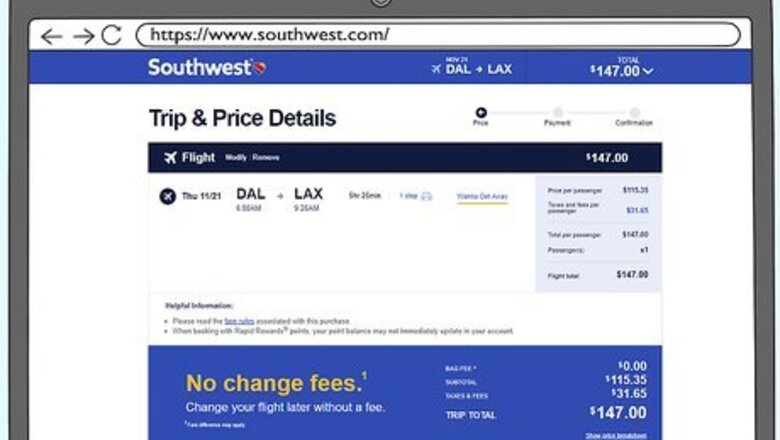
views
Planning for Your Trip
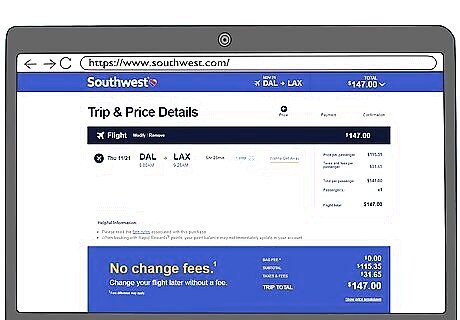
Buy a ticket. For most people, the easiest and most cost-effective way to buy a ticket is through an online travel site. If you prefer to talk to a person, you can call the airline directly, or use a travel agent. Once the ticket is purchased, you will receive an email confirmation with the option to either print your ticket at home or link it to your phone. You can also print your ticket at the airport. If using an online site, remember that not all airlines are represented. To find the prices and schedules for these airlines, such as Southwest Airlines, you will have to go to their individual websites.
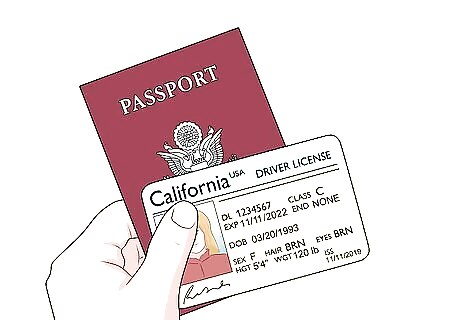
Have a photo ID. You will need to show a current photo ID card when you check in and again when you move through security. Check the airline website for a list of acceptable forms of ID. If you are flying internationally, you will need a passport, which is always accepted as proof of identification. If traveling internationally, be sure to find out if additional travel documents are needed. Some countries require visas that take several weeks to process.
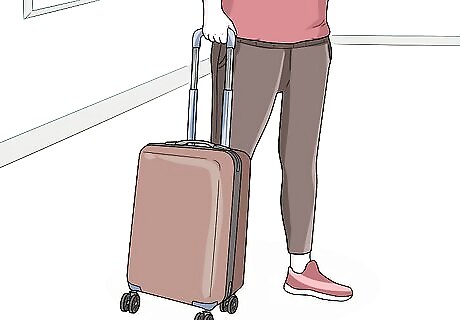
Pack efficiently. Most airlines charge a fee for every bag you need to check, usually starting at about $25 for the first bag and going up to more than $100 for additional bags. They will also charge additional fees for a bag weighing too much, usually more than 50 lbs. To avoid these fees, pack as lightly as possible.. If you can fit everything into one carry-on bag and one personal item, such as a purse or small backpack, you can usually avoid luggage fees altogether. Check the airline website for restrictions on what can be brought onboard in carry-on luggage. The primary restriction is that all liquids, gels, pastes, etc. need to be in 3.4 oz. (100 ml.) or smaller containers, and all your liquid containers need to fit into a clear, quart bag.
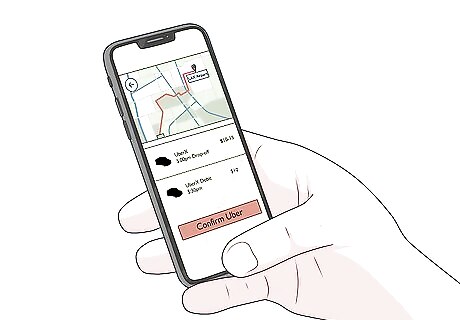
Plan how you are getting to the airport. If you are driving, check the airport website to get information on where to park. Give yourself extra time if you are taking a cab or Uber for the driver to arrive at your pick-up spot. Confirm train or bus schedules if you are taking public transportation. You do not want to add the stress of being late to your already hectic day.
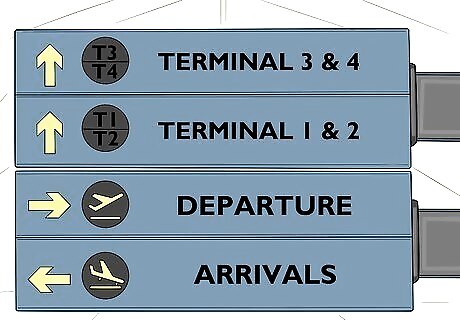
Know where to go. Before leaving the house, determine where you need to go at the airport to check in. You can usually find this information on the airport website. If it is not there, you will see signs as you drive up to the airport complex that will direct you to the right terminal. If you are parking in an economy lot away from the terminals, the airport will typically run a free shuttle to and from the terminal. Be sure to write down where your car is parked. All airport parking lots look alike, and it is easy to forget where you parked. If you are taking public transportation, check where you need to get off, and where you will pick it up again on your return.

Arrive at the airport 2–3 hours ahead of your flight time. Most airlines will not allow you on the flight if you are not checked in at least 30 minutes before the scheduled departure. If you only have carry-on luggage, you can save some time at the airport by checking in online at home or from your phone. You will then be able to skip the check-in counters at the airport and go directly to security.
Navigating the Airport

Check in. Follow the signs to the check-in area for your airline. Most airlines now have self-serve kiosks. Have your flight confirmation number ready, and follow the directions on the kiosk screen. The kiosk will print your boarding pass. Depending on the airline, it might also print a luggage tag. If the kiosk prints a luggage tag, follow directions to tag your luggage and take it to the luggage drop-off area. If it the kiosk does not print a luggage tag, an airline agent will call your name to come up to the desk to get your tag. Have your photo ID and ticket ready to show them. Some airlines have curbside check-in. This can be a good solution if you have a lot of bags or are short on time. Be sure to tip the curbside agent.
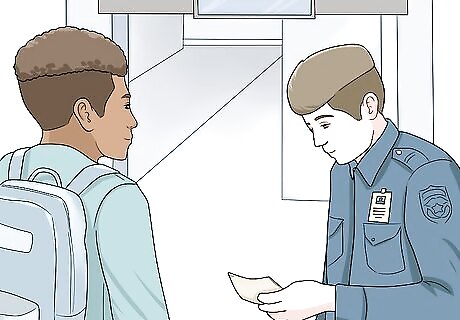
Go through security. After checking in, follow the signs for security. When you reach the front of the line, show the TSA agent your photo ID and boarding pass. Once these items are verified, grab a plastic bin and move to the conveyer belt. Put your shoes, belongings and bag of liquids in the bin. Use a second bin if the first becomes too crowded. Use a separate bin for your laptop. Most times and at most airports, the security process will take less than 20 minutes — sometimes much less. At some airports, however, especially around holiday times, it can take 45 minutes or more — sometimes much more — to get through security. Be patient. This is why you arrived early. Each country has its own security procedures, but all involve showing a photo ID and having your belongings scanned. If the system isn’t clear, airport personnel are always willing to help you get through them correctly. Don’t be afraid to ask if you have a question.
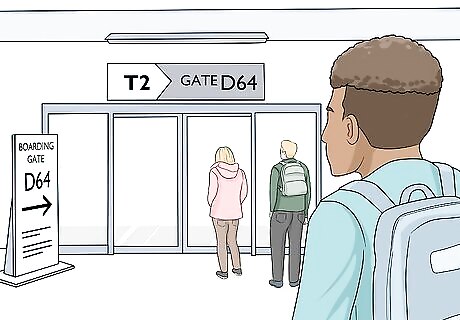
Go to your gate. Check the electronic displays to find your flight and gate number. Gates sometimes change, and the electronic boards will have the most updated information. Follow the signs to get to your gate. If you are early, feel free to wander into nearby stores or restrooms, but don’t go too far. You don’t want to miss the boarding call.
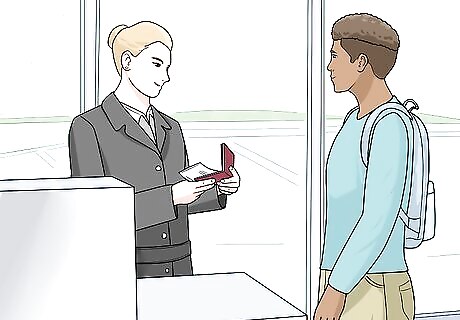
Board your flight. Airlines have specific boarding procedures. Check your ticket to find out your boarding number or zone. Wait for your number or zone to be called. The gate agents will explain the exact process before everyone starts boarding. Other passengers are also usually happy to help you navigate the system. If you are flying domestically, you will only need to present your boarding pass to the gate agent after your zone is called. If you are flying internationally, you might also be asked to show your passport, as well as any needed visas, at this time.

Find your seat. Seat numbers are located above each row. Find your seat and put your carry-on bag in the overhead bin nearest your seat. Put smaller items under the seat in front of you.. As a courtesy to other passengers, airlines ask that you only put one item in the overhead bin so there is room for everyone. If the overhead bins have filled before you board, you can put your carry-on under the seat in front of you, if it fits, or have the flight attendant check it. There will be no charge if it is checked.
Enjoying Your Flight
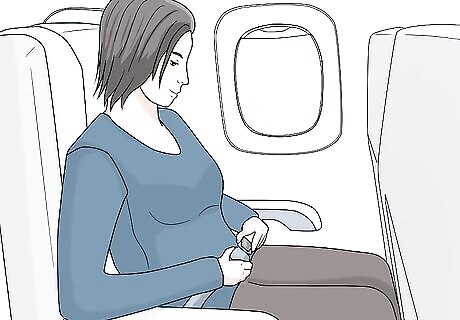
Take your seat. Once you have placed your bag in the overhead bin, take your seat and fasten your seat belt. If you are in a middle or window seat, you might have to ask someone who is already seated in your row to move into the aisle so you can get in. That’s OK. Everyone expects to do that.

Listen to the safety demonstration. The flight attendants will begin a safety demonstration after all the passengers are seated. Listen carefully and familiarize yourself with the procedures. It’s extremely unlikely that anything will happen, but it’s good to know what to do if it does. Even if the fasten seat belt sign is off, it’s a good idea to keep your belt fastened whenever you are seated. The pilot will normally let you know if the plane is entering a turbulent area, but sometimes there will be an unexpected rough patch. Don't worry about a few bumps. Airplanes are built to handle turbulence.

Enjoy the flight. Once you are air borne, the flight attendants will begin food and drink service. Most airlines provide free non-alcoholic beverages. Depending on the length of your flight, you might also have the option of purchasing meals, beer and other alcoholic drinks. If you want to eat on the plane, bring your own food. You can bring it from home if it doesn’t contain liquids, or purchase it at the airport. Most airlines now provide in-seat entertainment, so you can watch movies and other shows while flying. Many airlines now provide under-seat power ports to encourage passengers to bring their own tablets and laptops for their entertainment. You will also often be able to connect to a wifi system for an extra fee.
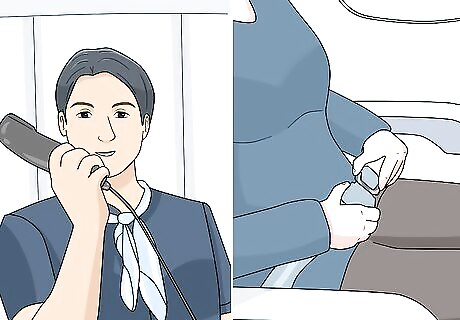
Get ready to land. Toward the end of the flight, the crew will make announcements to prepare everyone for landing. They will ask that large electronic devices be put away, and they will clear up any trash you might have.
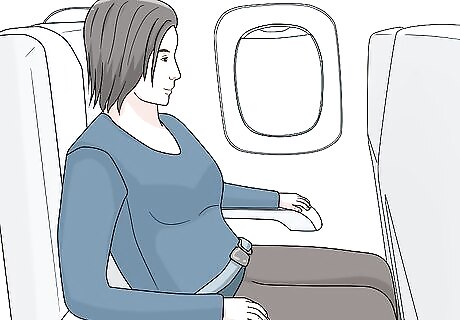
Stay in your seat after landing. After the airplane has landed, stay in your seat until the plane reaches its gate. When the plane is at the gate and stopped, the pilot will turn off the seat belt sign. Now is the time to unbuckle your seat belt.

Get off the plane. The front rows will leave the plane first, followed in turn by each following row. When it is your row’s turn, stand up, collect your bag from the overhead bin, and proceed down the aisle and out the door. While you are waiting for your turn, check to make sure you have everything you brought on. You will not be allowed to get back on the plane to get your phone if you leave it in the seat pocket.
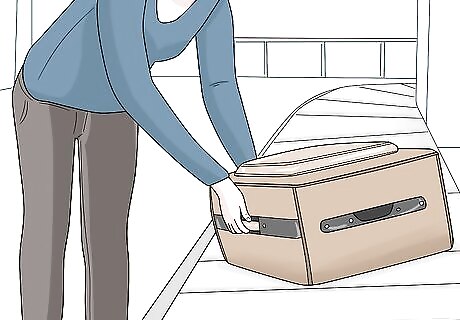
Get your baggage. Follow signs for baggage claim. Once in the area, there will be large electronic screens to guide you to the correct claim conveyor belt, where you can find your bags.



















Comments
0 comment